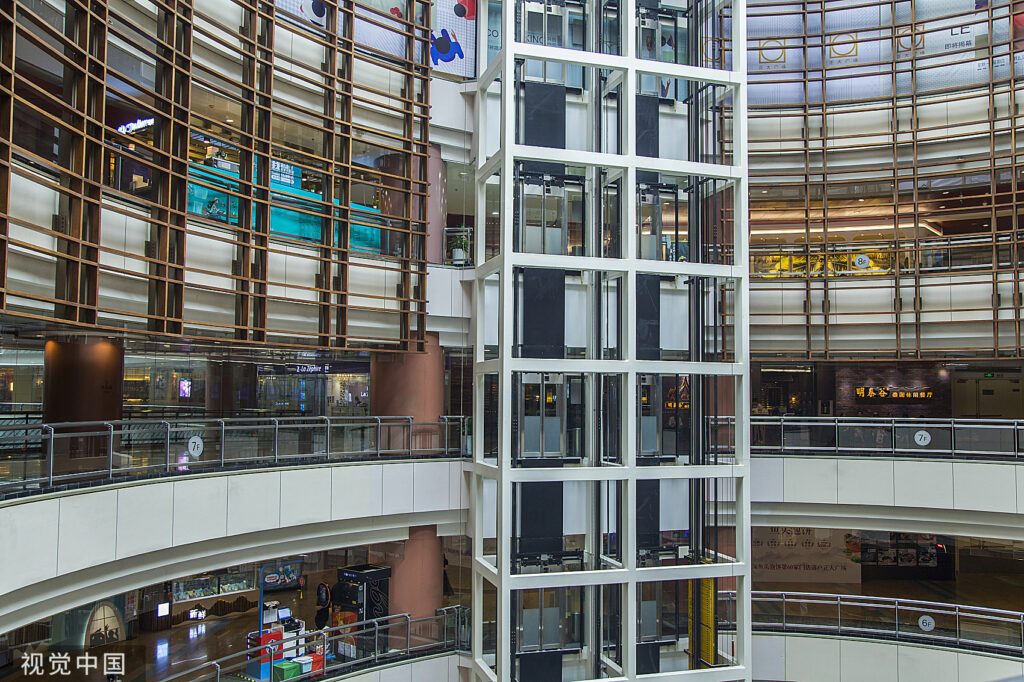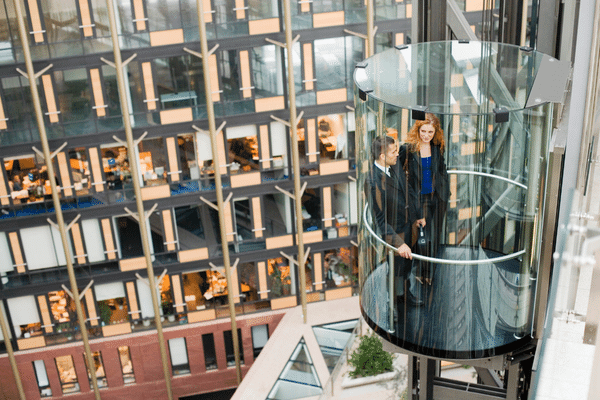What is a Panoramic Lift?
A panoramic lift is a device that lifts humans up and down. It consists of a platform that moves vertically, usually connected to a cable and winch in the basement. The platform can carry people and their belongings or transport goods.
1. The first step is to build the structure of the building where you want to install your panoramic lift.
2. You should install all necessary electrical components, such as light fixtures or air conditioners.
3. Then comes the installation of stairs inside the building so that people can easily access their apartments. The stairs can be made from different materials: wood or metal are some common choices for staircases in buildings with panoramic lifts installed on them; glass staircases can also be used as long as they’re sturdy enough to support heavy weights without breaking under pressure (this is especially true if they’re located near windows).
4. “Installing” means attaching one end of a cable onto something fixed in place (such as a wall) while attaching its other end to something else (like a car), pulling them both together until they’re close enough together that they won’t slip apart again.

How Does a Panoramic Lift Work?
The panoramic lift is used to lift objects to a higher elevation. It is common in the manufacturing industry and can be found in warehouses, supermarkets, and other similar facilities. The panoramic lift moves along a rail on which it is placed. Depending on the client’s application needs, this rail can be fixed or adjustable. The panoramic lift is powered by an electric motor and controlled by an operator who sits at its base. The operator uses this control panel to move the device and raise and lower its load.
The first step in how a panoramic lift works are for an operator to place the device onto a track that runs through a warehouse or other space where goods need to be moved around quickly and easily. The track must be installed correctly so that it does not cause damage to either itself or its surroundings over time due to wear and tear from frequent use; otherwise, this could lead to costly repairs down the road, which would require hiring an expert for them to fix any damage caused by improper installation such as cracks or holes drilled into concrete walls during installation time (if this happens then you should contact your local health department immediately).
Once appropriately installed, you will want to check the track regularly to ensure that there are no loose screws, bolts, or connectors that may cause damage to either yourself or your building.
When installing a handrail, it is essential to ensure that the rail is installed at least 36” above the surface of the stairway. This will allow you to use both hands when walking up or down the steps and will help prevent falls from happening in case anyone loses their balance while walking along your staircase.

What are the Benefits of a Panoramic Lift?
Panoramic lifts are an elevator that travels horizontally and vertically, allowing you to reach areas that would otherwise be impossible to access.
A panoramic lift is ideal for:
● Large warehouses and factories (think distribution centers)
● Warehouses with multiple levels or large rooms
● Warehouses with heavy machinery and equipment that needs to be moved around frequently
Benefits of a Panoramic Lift:
Safety: no more climbing stairs or ladders to reach high shelves or hard-to-reach areas. With the touch of a button, you can go from ground level to the top floor in a matter of seconds.
Efficiency: you’ll save time by not having to walk up and down stairs or climb ladders when moving products around your warehouse or factory. Plus, it’s easier on your knees!
Space Saving: if you’re short on space but need something that can travel vertically AND horizontally, then this might be just what you’ve been looking for!
Versatility: you can use a panoramic lift in many different ways! It’s not just for industrial settings; it also works well in offices, retail stores/malls, schools, and more.
Convenience: if you need something that can travel vertically AND horizontally, then this might be just what you’ve been looking for!

What are the Safety Features Included in a Panoramic Lift?
Safety features are included in a panoramic lift to ensure the safety of the passengers and prevent any damage to the lift itself. The safety features have been designed to keep the passengers safe while they are on a ride, and they are also designed to ensure that the lift is protected from any damage.
The primary safety feature of a panoramic lift is its ability to stop running in an emergency. If there is an emergency, such as an accident or damage, the lift will automatically stop running so that no one gets hurt. This means that no matter what happens during your ride on a panoramic lift, you can be sure that it will stop when it needs to and not run with anyone inside.
Another essential safety feature of a panoramic lift is its ability to protect itself from any damage that may occur during operation. This means that no matter what happens during your ride on a panoramic lift, you can be sure that it will continue operating safely without causing any damage or harm to anyone else.
This means that no matter what happens during your ride on a panoramic lift, you can be sure that it will continue operating safely without causing any damage or harm to anyone else. In addition to these safety features, it’s essential to know that a panoramic lift is designed with the ability to protect its passengers in case of an emergency. This means that no matter what happens during your ride on a panoramic lift, you can be sure that it will continue operating safely without causing any damage or harm to anyone else.
In addition to these safety features, it’s essential to know that a panoramic lift is designed with the ability to protect its passengers in case of an emergency. This means that no matter what happens during your ride on a panoramic lift, you can be sure that it will continue operating safely without causing any damage or harm to anyone else. In addition to these safety features, it’s essential to know that a panoramic lift is designed with the ability to protect its passengers in case of an emergency.

What Types of Buildings are Suitable for a Panoramic Lift?
Panoramic lifts are an excellent option for many buildings, but they have some limitations. Before you decide to install one, it’s essential to understand the types of structures that will work best with this technology.
First, let’s talk about spaces where you can’t use a panoramic lift. The first thing that comes to mind is a building with multiple floors. Since the lift only travels horizontally, it won’t be able to get your employees up and down from different levels of your building.
This also means that any location with too many obstacles in its path will also present problems. For example, if there are too many trees or tall vegetation around your building, they could block out some of the light needed by the solar panels on top of the cabins. This would make it impossible for those cabins to operate correctly!
Another thing to remember is that certain materials aren’t suitable for indoor use because they’re too expensive or difficult to clean up after accidents occur during installation work (like broken glass). Suppose you have doubts about whether or not this applies specifically to your company’s needs before installing a solar panel system on your cabins. In that case, it’s always a good idea to consult with an expert first.
If you’re still interested in installing a solar panel system on your cabins, you might want to consult an expert first. The last thing you want is for them to block out some of the light needed by the solar panels on top of the cabins!

How Much Does a Panoramic lift cost?
First, let’s talk about the most basic cost of any lift: installation. Installation costs vary widely depending on where you live, who installs the lift, and how complicated your site is. For example, if you have to dig up and replace electrical lines or move them underground, that will be more expensive than installing a standard panoramic lift that needs to be bolted into place.
The following cost to consider is maintenance. This includes regular inspections, maintenance checks, and any repairs required due to wear or tear.
Finally—and this is something that many people overlook—you’ll want to factor in taxes or other fees associated with purchasing equipment from an outside vendor like us! We can help you figure out what all these costs add to before you make a purchase decision so there are no surprises down the line! If you have any questions or want to get started on your own lift, email us at info@dazenelevator.com! Or contact us, and we will reply within 24 hours.
We are a licensed distributor of quality lifts and can help you find the right one for your needs. We can also provide maintenance and service as needed, so if you want to invest in a lift, give us a call today!

How Long Does It Take to Install a Panoramic Lift?
Installing a panoramic lift is a complex process that requires expertise and experience. Here, we’ll walk you through the steps.
Step 1: Decide on a location for your lift. The best place is near a power source and a water source, but any location that is accessible and where people will be comfortable using the lift will work.
Step 2: Lay out your plans for the lift, including the route from start to finish. The route should be marked with tape, so everyone knows their role in installing the lift. You’ll also need to specify how far apart each section of the track will be from one another, along with how many sections there are in total (each section is equal to one line of the track).
Step 3: Dig out trenches for each section of track based on your measurements from step two above – make sure there’s enough room around each trench so that nobody gets hurt if they happen to fall into one accidentally while working on installing this lift!
Step 4: Lay down boards over each trench so that nothing falls into them while installing these tracks; once again, you’ll want enough room around each trench so that nobody can accidentally fall in. Step 5: Lay down the tracks into the trenches that you dug out from step three above – make sure each track is level with one another and make sure they’re all facing the same direction for maximum efficiency.
Step 5: Cover up the tracks with dirt, making sure that there are no gaps between the tracks and the dirt below them; this will ensure that nobody gets hurt or falls into one of these trenches while working on installing your new lift.

What is the Maximum Capacity of a Panoramic Lift?
The maximum capacity of a panoramic lift is 3,000 pounds.
Panoramic lifts transport heavy loads, such as cars or appliances. They are also aerial lifts, boom lifts, or scissor lifts.
There are different types of panoramic lifts: electric and diesel-powered. Electric-powered models have a battery for power, while diesel-powered models use an internal combustion engine.
The maximum capacity of a panoramic lift can vary by model and manufacturer, but most will hold between 1,000 and 2,500 pounds. The higher this number, the more influential the machine will be and the larger it will be.
When choosing which type of panoramic lift to purchase, it’s essential to consider what kind of jobs you’ll need it for and whether or not they require holding heavy items like cars or appliances. If so, you’ll want a higher capacity to work efficiently without worrying about running out of juice during long shifts! Panoramic lifts are handy tools for anyone in construction, automotive repair, or any other field where they need to lift heavy items. These machines can also be used as a fun way to get around if you’re looking for an alternative to driving.
If you’re looking to buy a new panoramic lift, it’s essential to consider what kind of jobs you’ll need it for and whether or not they require holding heavy items like cars or appliances. If so, you’ll want a higher capacity to work efficiently without worrying about running out of juice during long shifts! Panoramic lifts are handy tools for anyone who works in construction, automotive repair, or any other field where they need them.

What is the Maximum Speed of a Panoramic Lift?
The maximum speed of a panoramic lift depends on the type of car used and the motor’s strength. Panoramic lifts are generally used in factories and warehouses to move large amounts of materials and products around quickly and efficiently.
The standard type of panoramic lift has two tracks on either side of its base, connected by gears and pulleys. The car sits atop these tracks and is pulled forward by a chain or cable running through the car’s center.
The strength of these motors can vary widely depending on what they’re being used for. A super-heavy-duty motor might lift to 100 tons per hour, while an average one will reach around 50 tons per hour. The higher-end models also have more powerful motors than those found in lower-end models, which means they can carry heavier loads or be used at faster speeds without causing too much damage if something goes wrong during the operation.” The strength of a car lift motor can be measured in many ways, including the amount of weight it can support and its speed. The motors in super-heavy-duty models are often much stronger than those in standard models, which means they can carry heavier loads or be used at faster speeds without causing too much damage if something goes wrong during the operation.”
The strength of a car lift motor can be measured in many ways, including the amount of weight it can support and its speed. The motors found in super-heavy-duty models are often much more robust than those found in standard models, which means they can carry heavier loads or be used at faster speeds without causing too much damage if something goes wrong during the operation.

Are There Any Special Requirements for the Installation of a Panoramic Lift?
Step 1: When choosing a panoramic lift, you should first consider the size of your warehouse. Panoramic lifts can be installed in warehouses with a length of up to 40 meters, and they are also suitable for smaller-sized warehouses. If you have a warehouse that is larger than this, you will need to install two or more panoramic lifts to cover the entire space.
Step 2: The next step is to decide on the location of your panoramic lift. It is best to place it on the top floor of your warehouse to access all parts of the building quickly. You should also ensure enough space around where you want to put it so that it does not interfere with other items or machinery in the area.
Step 3: Next comes choosing what kind of elevator system you would like for your new panoramic lift! There are many different types available today, including but not limited to: chain hoist system (which uses chains), cable hoist system (which uses cables), rope hoist system (which uses ropes), etc. Each one has its pros and cons, so make sure you do some research before making any decisions!
Step 4: After deciding which type of elevator you would like, it’s time to install it! You must ensure that the area where you plan to put your new panoramic lift is clear and free of any obstacles. The next step would be installing the concrete base for your new lift. After this, you can begin to install the actual lift itself. Jacks are used to raise the elevator into place, and then it will be secured with bolts so that it will not fall over. Of course, you must ensure everything is installed correctly before operating your new elevator!

